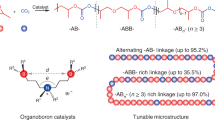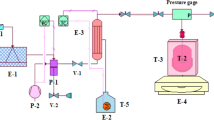Abstract
Liquid and supercritical carbon dioxide have attracted much interest as environmentally benign solvents1, but their practical use has been limited by the need for high CO2 pressures to dissolve even small amounts of polar, amphiphilic, organometallic, or high-molecular-mass compounds2,3,4. So-called ‘CO2-philes’ efficiently transport insoluble or poorly soluble materials into CO2 solvent, resulting in the development of a broad range of CO2-based processes, including homogeneous and heterogeneous polymerization, extraction of proteins and metals, and homogeneous catalysis5,6,7,8,9,10,11. But as the most effective CO2-philes are expensive fluorocarbons, such as poly(perfluoroether), the commercialization of otherwise promising CO2-based processes has met with only limited success. Here we show that copolymers can act as efficient, non-fluorous CO2-philes if their constituent monomers are chosen to optimize the balance between the enthalpy and entropy of solute–copolymer and copolymer–copolymer interactions. Guided by heuristic rules regarding these interactions, we have used inexpensive propylene and CO2 to synthesize a series of poly(ether-carbonate) copolymers that readily dissolve in CO2 at low pressures. Even though non-fluorous polymers are generally assumed to be CO2-phobic, we expect that our design principles can be used to create a wide range of non-fluorous CO2-philes from low-cost raw materials, thus rendering a variety of CO2-based processes economically favourable, particularly in cases where recycling of CO2-philes is difficult.
This is a preview of subscription content, access via your institution
Access options
Subscribe to this journal
Receive 51 print issues and online access
$199.00 per year
only $3.90 per issue
Buy this article
- Purchase on Springer Link
- Instant access to full article PDF
Prices may be subject to local taxes which are calculated during checkout




Similar content being viewed by others
References
Eckert, C. A., Knutson, B. L. & Debenedetti, P. G. Supercritical fluids as solvents for chemical and materials processing. Nature 373, 313– 318 (1996).
Consani, K. A. & Smith, R. D. Observation on the solubility of surfactants and related molecules in carbon dioxide at 50 °C. J. Supercrit. Fluids 3, 51–65 (1990),
O'Shea, K. E., Kirmse, K. M., Fox, M. A. & Johnston, K. P. Polar and hydrogen-bonding interactions in supercritical fluids. Effects on the tautomeric equilibrium of 4-(phenylazo)-1-naphthol. J. Phys. Chem. 95, 7863–7867 ( 1991).
Johnston, K. P. & Lemert, R. M. in Encyclopedia of Chemical Processing and Design Vol. 56 (ed. McKetta, J. J.) 1–45 (Dekker, New York, 1996 ).
Harrison, K., Goveas, J., Johnston, K. P. & O'Rear, E. A. Water-in-carbon dioxide microemulsions with a fluorocarbon-hydrocarbon hybrid surfactant. Langmuir 10, 3536– 3541 (1994).
DeSimone, J. M., Guan, Z. & Elsbernd, C. S. Synthesis of fluoropolymers in supercritical carbon dioxide. Science 267, 945– 947 (1992).
Hsiao, Y. L., Maury, E. E., DeSimone, J. M., Mawson, S. M. & Johnston, K. P. Dispersion polymerization of methyl-methacrylate stabilized with poly(1,1-dihydroperfluorooctyl acrylate) in supercritical carbon dioxide. Macromolecules 28, 8159–8166 (1995).
Ghenciu, E. G., Russell, A. J., Beckman, E. J., Steele, L. & Becker, N. T. Solubilization of subtilisin in CO2 using fluoroether-functional amphiphiles. Biotech. Bioeng. 58, 572–580 ( 1998).
Johnston, K. P. et al.Water in carbon dioxide microemulsions: An environment for hydrophiles including proteins. Science 271, 624–626 (1996).
Yazdi, A. V. & Beckman, E. J. Design of highly CO2-soluble chelating agents. 2. Effect of chelate structure and process parameters on extraction efficiency. Ind. Eng. Chem. Res. 36, 2368–2374 (1997).
Jessop, P. G., Ikariya, T. & Noyori, R. Homogeneous catalysis in supercritical fluids. Chem. Rev. 99, 475–494 ( 1999).
O'Neill, M. L. et al. Solubility of homopolymers and copolymers in carbon dioxide. Ind. Eng. Chem. Res. 37, 3067– 3079 (1998).
Rindfleisch, F., DiNoia, T. P. & McHugh, M. A. Solubility of polymers in supercritical CO2 . J. Phys. Chem. 100, 15581– 15587 (1996).
Meredith, J. C., Johnston, K. P., Seminario, J. M., Kazarian, S. G. & Eckert, C. A. Quantitative equilibrium constants between CO2 and Lewis bases from FTIR spectroscopy. J. Phys. Chem. 100, 10837– 10848 (1996).
Kazarian, S. G., Vincent, M. F., Bright, F. V., Liotta, C. L. & Eckert, C. A. Specific intermolecular interaction of carbon dioxide with polymers. J. Am. Chem. Soc. 118, 1729–1736 (1996).
Brandrup, J., Immergut, E. H. & Grulke, E. A. (eds) Polymer Handbook 4th edn Ch. VII, 47–68 (Wiley, New York,1999).
Fink, R., Hancu, D., Valentine, R. & Beckman, E. J. Toward the development of “CO2-philic” hydrocarbons. 1. Use of side-chain functionalization to lower the miscibility pressure of polydimethylsiloxanes in CO2. J. Phys. Chem. B 103, 6441–6444 (1999).
Hoefling, T. A., Enick, R. M. & Beckman, E. J. Microemulsions in near critical and supercritical CO2. J. Phys. Chem. 95, 7127–7129 (1991).
Li, J. & Beckman, E. J. Affinity extraction into CO 2. 2. Extraction of heavy metals into CO2 low-pH aqueous solutions. Ind. Eng. Chem. Res. 37, 4768 –4773 (1998).
Triolo, F. et al. Critical micelle density for the self-assembly of block copolymer surfactants in supercritical carbon dioxide. Langmuir 16, 416–421 (2000).
Hoefling, T. A., Newman, D. A., Enick, R. M. & Beckman, E. J. Effect of structure on the cloud point curves of silicone-based amphiphiles in supercritical carbon dioxide. J. Supercrit. Fluids 6, 165–171 (1993).
Newman, D. A., Hoefling, T. A., Beitle, R. R., Beckman, E. J. & Enick, R. M. Phase behavior of fluoroether-functional amphiphiles in supercritical carbon dioxide. J. Supercrit. Fluids 6, 205–210 ( 1993).
Lepilleur, C. & Beckman, E. J. Dispersion polymerization of methyl methacrylate in CO2. Macromolecules 30, 745–750 (1997).
Acknowledgements
We thank the US DOE, National Petroleum Technology Office, for their support of our CO2 enhanced oil recovery research, and the US DOE, National Energy Technology Laboratory, for their support of our CO2 well fracturing research.
Author information
Authors and Affiliations
Corresponding author
Rights and permissions
About this article
Cite this article
Sarbu, T., Styranec, T. & Beckman, E. Non-fluorous polymers with very high solubility in supercritical CO2 down to low pressures. Nature 405, 165–168 (2000). https://doi.org/10.1038/35012040
Received:
Accepted:
Issue Date:
DOI: https://doi.org/10.1038/35012040
This article is cited by
-
Synthesis of CO2-philic/hydrophilic surfactant with brush structure and its application in preparing monolithic materials
Journal of Polymer Research (2024)
-
Designing quaternized di-N-chloramine silicone with synergistic biocidability for CO2-asssisted interpenetration into cellulose
Cellulose (2023)
-
Interactions of acylated methylglucoside derivatives with CO2: simulation and calculations
Journal of Molecular Modeling (2016)
Comments
By submitting a comment you agree to abide by our Terms and Community Guidelines. If you find something abusive or that does not comply with our terms or guidelines please flag it as inappropriate.



